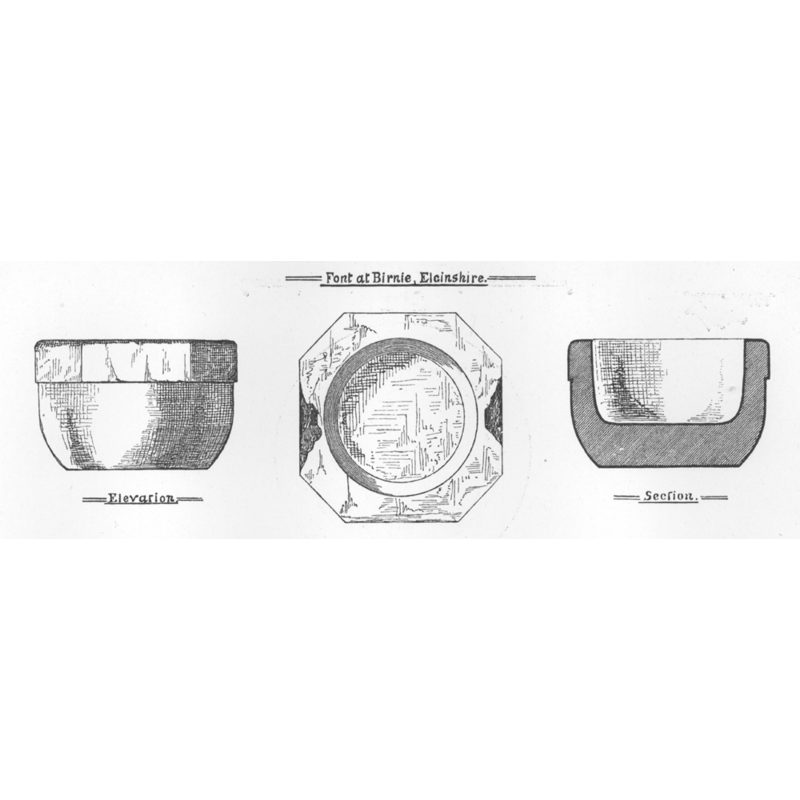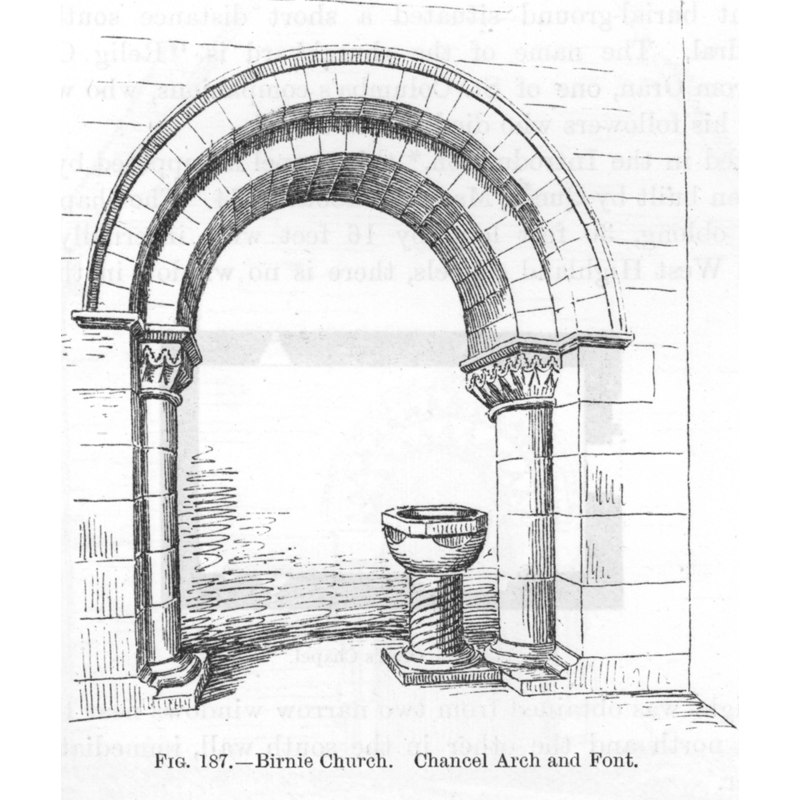Birnie

Image copyright © [in the public domain]
PD
Results: 2 records
view of church interior - chancel arch
INFORMATION
FontID: 00923BIR
Object Type: Baptismal Font1
Church/Chapel: Parish Church of St. Brendan
Church Patron Saints: St. Brendan [aka Brendan of Clonfert, Brandon the Navigator, Brendan the Abbot, Brendan the Anchorite, Brendan the Bold]
Country Name: Scotland
Location: Moray
Directions to Site: Located off road B9010, 5 km S of Elgin
Historical Region: formerly Elginshire
Font Location in Church: Under the chancel arch [ca. 1896]
Century and Period: 12th - 13th century, Romanesque
Church Notes: MacGibbon & Ross (ibid., v. 1: p. 218, 219) inform that the church is dedicated to St. Brendan and is of Norman workmanship: "the architecture, though simple, is good, and, together with the chancel arch, indicates a rather advanced date in the Norman period, probably towards the end of the twelfth century."
Font Notes:
Click to view
Muir (1861) reports a refined specimen "of pure Norman date" in Birnie Church. Described and illustrated in Walker (1887) as an early, possibly 13th-century, basin the upper part of which is an irregular octagon while the rest of the sides and underbowl are rounded. The inside well is round and has no drain, but the staple holes for the cover are evident. Described and illustrated in MacGibbon & Ross (1896-1897, vol. I) as "a very interesting relic of Norman design, probably of older date than the church. This is the stone font, the upper part of which consists of a semi-hemispherical stone basin, with portions cut off vertically, like a cushion cap, while the top plinth has small portions at the angles cut off, thus making it an irregular octagon. The pedestal on which the basin rests is circular, and is fluted with small spirals passing round it. This, we understand, was supplied recently." The entry for this church in the CRSBI [https://www.crsbi.ac.uk/view-item?i=8666] [accessed 12 February 2025] describes the font in it: "Only the upper bowl of the baptismal font is original. It had, presumably at the Reformation, been put outside in the churchyard, where the damage is likely to have occurred. The lower support column and base appear, however, to have been made during the 19th-century restorations. In the Statistical Account of 1793, it is stated that the font had been preserved and in the 1845 Statistical Account it was reconfirmed that it was inside the church. Carved simply, the outer face of the upper bowl consists of a lower, rounded section topped by a plain, octagonal rim of squared profile at the top. The top and bottom of the inner basin are circular, but there is no drainage hole in the concavity".
COORDINATES
Church Latitude & Longitude Decimal: 57.611291, -3.328904
Church Latitude & Longitude DMS: 57° 36' 40.7" N, 3° 19' 44.1" W
MEDIUM AND MEASUREMENTS
Material: stone, type unknown
Number of Pieces: two? {modern base]
Font Shape: octagonal (mounted) [modern base]
Basin Interior Shape: round
Basin Exterior Shape: octagonal
Rim Thickness: 8-9 cm
Diameter (inside rim): 42.5 cm
Diameter (includes rim): 59 cm
Basin Depth: 22.5 cm
Basin Total Height: 35 cm
Square Base Dimensions: [original base missing]
Notes on Measurements: Walker (1887)
REFERENCES
MacGibbon, David, Ecclesiastical Architecture of Scotland: from the Earliest Christian Times to the Seventeenth Century, Edinburgh: D. Douglas, 1896-1897
Muir, Thomas S., Characteristic of Old Church Architecture &c. in the Mainland and Western Islands of Scotland, Edinburgh: Edmonston & Douglas, 1861
Walker, J. Russell, "Scottish Baptismal Fonts", 21 or N.S. 9, Proceedings of the Society of Antiquaries of Scotland, 1887, pp. 346-448; p. 354 and ill. on p. 355
